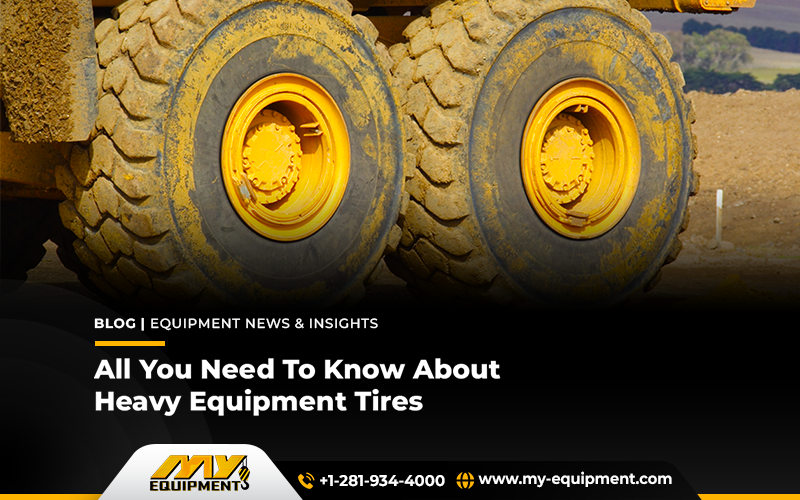Tires are one of the major workhorses that come under the list of top operating expenses for maintaining heavy equipment.
So to maintain tire safety and overall condition you need to be strategic and adaptive. As the better the tires the greater will be the construction operation’s efficiency.
So when it’s about transporting heavy equipment you surely can’t miss out on safety. Therefore, you have to place a set of safety regulations that can induce a protective workplace for all.
Having said that, the benefits of putting efforts into tire quality will be seen in your day-to-day construction tasks.
A maintained heavy equipment tire offers a smooth execution of operations especially when 90% of the construction grounds are either rough or slippery.
Here are a few essential tire maintenance practices for increased uptime and operator safety besides the reduction of uncertain failures. costly, preventable failure
Selection
The type of tire affects your overall operational efficiency, financial graph, and workplace safety.
You need to first analyze your regular operations and grounds so that you can select a tire with complimentary attributes.
Buying cheap tires can affect the project optimization rate adversely as they won’t last long.
Correct Tire Tread
To find the right tire pattern you first have to see the intended usage. Tires offer diversity in terms of different tread patterns and depth to entertain different operations onsite.
Treads have numbers and are selected based on the construction ground’s nature and the heavy equipment’s strength.
Other factors that help in selecting a suitable tire tread type are as follows;
- Soil type
- Road surface
- Traction and abrasion level
- Cut and damage risks
TMPH
For selecting the task-appropriate tire you must know the TMPH. It stands for Ton-Miles Per Hour, and it represents the significant attribute of your tire’s operational capability.
Wheel And Other Attachments
We as used heavy equipment dealers advise all buyers to consult with experts before selecting the wheels.
The specification of weels is decided by the equipment manufacturers and after consulting them you can decide which feel or attachment can add productivity to your entire process.
Tire Inflation
The right amount of tire inflation will positively increase the overall operation’s optimization. It helps in smoothening the heavy equipment’s motion on rough grounds and most importantly promises the operator’s safety.
Under or over heavy equipment tires can cause serious safety concerns and tire damage. Make sure you read the user guide by tire manufacturers to maintain the recommended tire pressure.
According to one of the leading tire manufacturers, Michelin both the over-inflated and under-inflated tires can pose a threat to the entire construction unit.
If you want to learn more about the Michelin tire market and how it can level up your heavy equipment’s performance learn more about it via Michelin Tires: The Next Big Addition To Your Inventory.
Instant pressure loss or insufficient pressure can raise the temperature which can generate irreversible machinery loss.
Get hands-on quality and reasonable Michelin tires at MY-Equipment.com, here you can find relevant attachments too!
Pro Tip:
Make sure you maintain equal tire pressure among dual heavy equipment tires
Prevent Pyrolysis
If the rubber of tires gets heated it produces a chemical reaction called pyrolysis. This process deteriorates the overall tire performance.
This deterioration can cause extreme pressure at points where it can lead to tire bursts.
The process of pyrolysis can extend from seconds to hours. However, no one can predict it as there are no visible symptoms until the explosion occurs.
Must-Have Tire Inspection To Do Regularly
As a responsible fleet manager, you must provide all the operators with a pressure gauge to inspect tires daily before the operation starts.
In addition, take guidance from the user manual and check the tie pressure or carried load’s weight accordingly.
- Check the tread, see if there’s any sign of wear or tear, cuts or detachments
- Analyze the tire sidewalls for bulges, bubbles, cuts, and cracks
- Inspect the bead for potential bluing, deformation, and cracks
- Inspect the wheel to see broken studs, cracks, tears, or loose lug nuts
- Identify the rim for bents or cracks
- Clean the tires with efficient soap and warm water only
- In terms of any defect, inform the respective authorities immediately
Takeaway
Neglecting the earth of a heavy equipment tire can affect the optimization and productivity rate of the entire process. It can increase unpredictable tire failure as well as add up as an expense cost.
On the same side, sudden tire failure increases health hazards for the operators and workers nearby.
If you take all the above-mentioned factors and tops under consideration you increase the lifespan of a tire and increase your overall construction rate.


 1400 Broadfield Blvd, Houston, TX 77084,
USA.
1400 Broadfield Blvd, Houston, TX 77084,
USA.